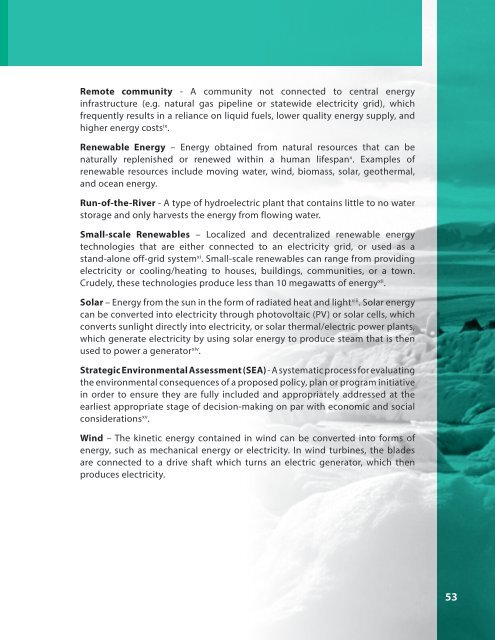DEVELOPING RENEWABLE ENERGY IN ARCTIC AND SUB-ARCTIC REGIONS AND COMMUNITIES
FulbrightArcRenewableEnergy
FulbrightArcRenewableEnergy
Create successful ePaper yourself
Turn your PDF publications into a flip-book with our unique Google optimized e-Paper software.
Remote community - A community not connected to central energy<br />
infrastructure (e.g. natural gas pipeline or statewide electricity grid), which<br />
frequently results in a reliance on liquid fuels, lower quality energy supply, and<br />
higher energy costs ix .<br />
Renewable Energy – Energy obtained from natural resources that can be<br />
naturally replenished or renewed within a human lifespan x . Examples of<br />
renewable resources include moving water, wind, biomass, solar, geothermal,<br />
and ocean energy.<br />
Run-of-the-River - A type of hydroelectric plant that contains little to no water<br />
storage and only harvests the energy from flowing water.<br />
Small-scale Renewables – Localized and decentralized renewable energy<br />
technologies that are either connected to an electricity grid, or used as a<br />
stand-alone off-grid system xi . Small-scale renewables can range from providing<br />
electricity or cooling/heating to houses, buildings, communities, or a town.<br />
Crudely, these technologies produce less than 10 megawatts of energy xii .<br />
Solar – Energy from the sun in the form of radiated heat and light xiii . Solar energy<br />
can be converted into electricity through photovoltaic (PV) or solar cells, which<br />
converts sunlight directly into electricity, or solar thermal/electric power plants,<br />
which generate electricity by using solar energy to produce steam that is then<br />
used to power a generator xiv .<br />
Strategic Environmental Assessment (SEA) - A systematic process for evaluating<br />
the environmental consequences of a proposed policy, plan or program initiative<br />
in order to ensure they are fully included and appropriately addressed at the<br />
earliest appropriate stage of decision-making on par with economic and social<br />
considerations xv .<br />
Wind – The kinetic energy contained in wind can be converted into forms of<br />
energy, such as mechanical energy or electricity. In wind turbines, the blades<br />
are connected to a drive shaft which turns an electric generator, which then<br />
produces electricity.<br />
53


